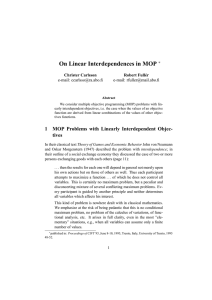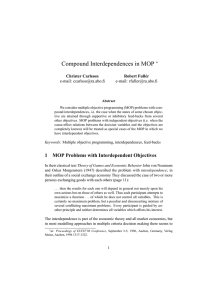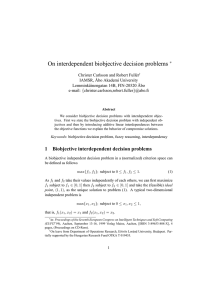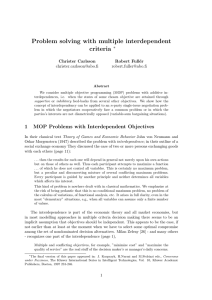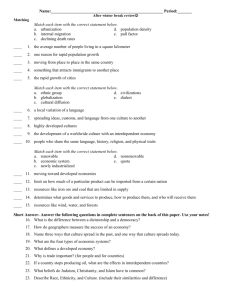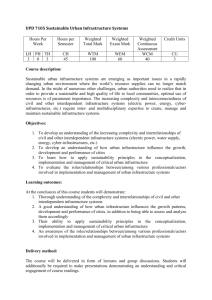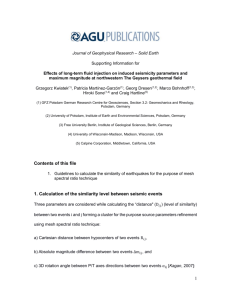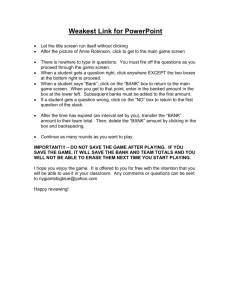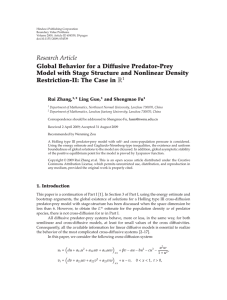Additive Interdependences in MOP ∗ Christer Carlsson Robert Full´er
advertisement
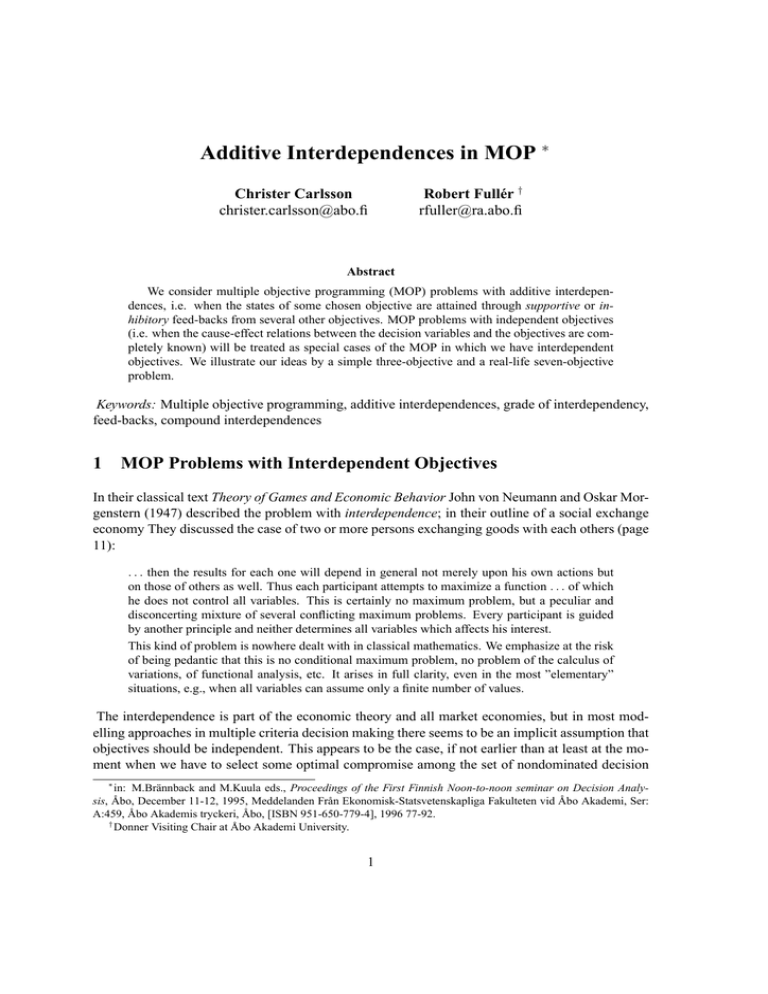
Additive Interdependences in MOP ∗
Christer Carlsson
christer.carlsson@abo.fi
Robert Fullér †
rfuller@ra.abo.fi
Abstract
We consider multiple objective programming (MOP) problems with additive interdependences, i.e. when the states of some chosen objective are attained through supportive or inhibitory feed-backs from several other objectives. MOP problems with independent objectives
(i.e. when the cause-effect relations between the decision variables and the objectives are completely known) will be treated as special cases of the MOP in which we have interdependent
objectives. We illustrate our ideas by a simple three-objective and a real-life seven-objective
problem.
Keywords: Multiple objective programming, additive interdependences, grade of interdependency,
feed-backs, compound interdependences
1
MOP Problems with Interdependent Objectives
In their classical text Theory of Games and Economic Behavior John von Neumann and Oskar Morgenstern (1947) described the problem with interdependence; in their outline of a social exchange
economy They discussed the case of two or more persons exchanging goods with each others (page
11):
. . . then the results for each one will depend in general not merely upon his own actions but
on those of others as well. Thus each participant attempts to maximize a function . . . of which
he does not control all variables. This is certainly no maximum problem, but a peculiar and
disconcerting mixture of several conflicting maximum problems. Every participant is guided
by another principle and neither determines all variables which affects his interest.
This kind of problem is nowhere dealt with in classical mathematics. We emphasize at the risk
of being pedantic that this is no conditional maximum problem, no problem of the calculus of
variations, of functional analysis, etc. It arises in full clarity, even in the most ”elementary”
situations, e.g., when all variables can assume only a finite number of values.
The interdependence is part of the economic theory and all market economies, but in most modelling approaches in multiple criteria decision making there seems to be an implicit assumption that
objectives should be independent. This appears to be the case, if not earlier than at least at the moment when we have to select some optimal compromise among the set of nondominated decision
∗
in: M.Brännback and M.Kuula eds., Proceedings of the First Finnish Noon-to-noon seminar on Decision Analysis, Åbo, December 11-12, 1995, Meddelanden Från Ekonomisk-Statsvetenskapliga Fakulteten vid Åbo Akademi, Ser:
A:459, Åbo Akademis tryckeri, Åbo, [ISBN 951-650-779-4], 1996 77-92.
†
Donner Visiting Chair at Åbo Akademi University.
1
alternatives. Milan Zeleny [9] - and many others - recognizes one part of the interdependence (page
1),
Multiple and conflicting objectives, for example, ”minimize cost” and ”maximize the quality
of service” are the real stuff of the decision maker’s or manager’s daily concerns. Such problems are more complicated than the convenient assumptions of economics indicate. Improving
achievement with respect to one objective can be accomplished only at the expense of another.
but not the other part: objectives could support each others. We will in the following explore the
consequences of allowing objectives to be interdependent.
2
Additive linear interdependences in MOP
Objective functions of a multiple objective programming problem are usually considered to be
independent from each other, i.e. they depend only on the decision variable x. A typical statement
of an MOP with independent objective functions is
max{f1 (x), . . . , fk (x)}
x∈X
(1)
where fi is the i-th objective function, x is the decision variable, and X is a subset, usually defined
by functional inequalities. Throughout this paper we will assume that the objective functions are
normalized, i.e. fi (x) ∈ [0, 1] for each x ∈ X.
However, as has been shown in some earlier work by by Carlsson and Fullér [1, 2, 3, 4], and
Felix [7], there are management issues and negotiation problems, in which one often encounters the
necessity to formulate MOP models with interdependent objective functions, in such a way that the
objective functions are determined not only by the decision variables but also by one or more other
objective functions.
Typically, in complex, real-life problems, there are some unidentified factors which effect the values of the objective functions. We do not know them or can not control them; i.e. they have an
impact we can not control. The only thing we can observe is the values of the objective functions
at certain points. And from this information and from our knowledge about the problem we may be
able to formulate the impacts of unknown factors (through the observed values of the objectives).
First we state the multiobjective decision problem with independent objectives and then adjust our
model to reality by introducing interdependences among the objectives.
Interdependences among the objectives exist whenever the computed value of an objective function
is not equal to its observed value. In this paper we claim that the real values of an objective function
can be identified by the help of feed-backs from the values of other objective functions.
Suppose now that the objectives of (1) are interdependent, and the value of an objective function is
determined by a linear combination of the values of other objectives functions. That is
fi (x) = fi (x) +
k
j=1, j=i
2
αij fj (x), 1 ≤ i ≤ k
(2)
or, in matrix format
f1 (x)
f2 (x)
..
.
fk (x)
=
1 α12 . . . α1k
α21 1 . . . α2k
..
..
..
..
.
.
.
.
αk1 αk2 . . . 1
f1 (x)
f2 (x)
..
.
fk (x)
where αij is a real numbers denoting the grade of interdependency between fi and fj .
If αij > 0 then we say that fi is supported by fj ; if αij < 0 then we say that fi is hindered by fj ;
if αij = 0 then we say that fi is independent from fj (or the states of fj are irrelevant to the states
of fi ).
The matrix of interdependences, (αij ), denoted by I(f1 , . . . , fk ), and defined by
I(f1 , . . . , fk ) =
1 α12 . . . α1k
α21 1 . . . α2k
..
..
..
..
.
.
.
.
αk1 αk2 . . . 1
is called the interdependency matrix of (1).
α ij f j ( x)
1
1
Fig. 1
f j ( x)
f j ( x)
α ij f j ( x)
Linear feed-back with αij > 0 and αij < 0
In such cases, i.e. when the feed-backs from the objectives are directly proportional to their independent values, then we say that the objectives are linearly interdependent.
It is clear that if αij = 0, ∀i = j, i.e.
I(f1 , . . . , fk ) =
1 0 ... 0
0 1 ... 0
.. .. .. ..
. . . .
0 0 ... 1
then we have an MOP problem with independent objective functions.
The grade of interdependency, denoted by ∆(fi ), of an objective function fi is defined by [3]
∆(fi ) =
sign(αji ) =
i=j
αji >0,i=j
1−
1
αji <0
i.e. ∆(fi ) is nothing else that the number of objectives supported by fi minus the number of
objectives hindered by fi , i = 1, . . . , k.
3
If ∆(fi ) is positive and large then fi supports a majority of the objectives; if ∆(fi ) is negative and
large then fi is in conflict with a majority of the objectives; if ∆(fi ) is positive and small then fi
supports more objectives than it hinders, and if ∆(fi ) is negative and small then fi hinders more
objectives than it supports. Finally, if ∆(fi ) = 0 then fi is independent from the others or supports
the same number of objectives as it hinders.
Taking into consideration the linear interdependences among the objective functions (2), (1) turns
into the following problem (which is treated as an independent MOP)
max{f1 (x), . . . , fk (x)}
(3)
x∈X
It is clear that the solution-sets of (1) and (3) are usually not identical.
A typical case of interdependence is the following (almost) real world situation. We want to buy a
house for which we have defined the following three objectives
• f1 : the house should be non-expensive
• f2 : as we do not have the necessary skills, the house should not require much maintenance
or repair work
• f3 : the house should be more than 10 year old so that the garden is fully grown and we need
not look at struggling bushes and flowers
We have the following interdependences:
• f1 is supported by both f2 and f3 as in certain regions it is possible to find 10 year old houses
which (for the moment) do not require much repair and maintenance work, and which are
non-expensive.
• f2 can be conflicting with f3 for some houses as the need for maintenance and repair work
increases with the age of the house; thus f3 is also conflicting with f2 .
• f3 is supporting f1 for some houses; if the garden is well planned it could increase the price,
in which case f3 would be in partial conflict with f1 ; if the neighbourhood is completed and
no newbuilding takes place, prices could rise and f3 be in conflict with f1 .
To explain the issue more exactly, consider a three-objective problem with linearly interdependent
objective functions
(4)
max{f1 (x), f2 (x), f3 (x)}
x∈X
Taking into consideration that the objectives are linearly interdependent, the interdependent values
of the objectives can be expressed by
f1 (x) = f1 (x) + α12 f2 (x) + α13 f3 (x), f2 (x) = f2 (x) + α21 f1 (x) + α23 f3 (x)
f3 (x) = f3 (x) + α31 f1 (x) + α32 f2 (x)
That is
f1 (x)
1 α12 α13
f1 (x)
f
(x)
α
1
α
=
2
21
23 f2 (x)
α31 α32 1
f3 (x)
f3 (x)
4
For example, depending on the values of αij we can have the following simple linear interdependences among the objectives of (4)
• if α12 = 0 then we say that f1 is independent from f2 ;
• if α12 > 0 then we say that f2 unilaterally supports f1 ;
• if if α12 < 0 then we say that f2 hinders f1 ;
• if α12 > 0 and α21 > 0 then we say that f1 and f2 mutually support each others;
• if α12 < 0 and α21 < 0 then we say that f1 and f2 are conflicting;
• if α12 + α21 = 0 then we say that f1 are f2 are in a trade-off relation;
It is clear, for example, that if f2 unilaterally supports f1 then the larger the improvement f2
(supporting objective function) the more significant is its contribution to f1 (supported objective
function).
f2
α2 1
α2 3
α1 2
f1
Fig. 2
α3 2
α1 3
α3 1
f3
A three-objective interdependent problem with linear feed-backs.
To illustrate our ideas consider the following simple decision problem.
max{x, 1 − x}
(5)
x ∈ [0, 1]
Choosing the minimum-norm to aggregate the values of objective functions this problem has a
unique solution x∗ = 1/2 and the optimal values of the objective functions are (0.500, 0.500).
1
0 .5
0 .5
1
5
Fig. 3
Independent problem.
Suppose that for example f1 is unilaterally supported by f2 on the whole decision space [0, 1] and
the degree of support is given by
f1 (x) = f1 (x) + 1/2f2 (x) = x + 1/2(1 − x) = 1/2 + x/2
Then (5) turns into the following problem
max{1/2 + x/2, 1 − x}
x ∈ [0, 1]
Choosing the minimum-norm to aggregate the values of objective functions this problem has a
unique solution x∗ = 1/3 and the optimal values of the objective functions are (0.667, 0.667).
1
2/3
1/3
1
Fig. 4
Unilateral support.
Suppose now that f1 and f2 support each other mutually, i.e. the better the value of f1 the more
significant is its support to f2 and vica versa. The degrees of supports are given by
f1 (x) = f1 (x) + 1/2f2 (x) = x + 1/2(1 − x) = 1/2(1 + x)
f2 (x) = f2 (x) + 1/2f1 (x) = (1 − x) + 1/2x = 1 − x/2
In this case our interdependent problem turns into
max{1/2(1 + x), 1 − x/2}
x ∈ [0, 1]
Choosing the minimum-norm to aggregate the values of objective functions this problem has a
unique solution x∗ = 1/2 and the optimal values of the objective functions are (0.750, 0.750).
6
1
.7 5
1
0 .5
Fig. 5
Mutual support.
Suppose now that f2 hinders f1 , i.e. the better the value of f2 the more significant is its negative
feed-back to f1 . The degree of hindering is
f (x) = f1 (x) − 1/2(1 − x) = x − 1/2 + 1/2x = 3/2x − 1/2
So our interdependent problem turns into
max{3/2x − 1/2, 1 − x}
x ∈ [0, 1]
Choosing the minimum-norm to aggregate the values of objective functions this problem has a
unique solution x∗ = 3/5 and the optimal values of the objective functions are (0.400, 0.400).
1
.4
0 .6
1
Fig. 6
Hindering.
Suppose now that f2 hinders f1 , but f1 supports f2
f1 (x) = f1 (x) − 1/2f2 (x) = x − 1/2(1 − x) = 3/2x − 1/2
f2 (x) = f2 (x) + 1/2f1 (x) = (1 − x) + 1/2x = 1 − x/2
So our interdependent problem turns into
max{3/2x − 1/2, 1 − x/2}
x ∈ [0, 1]
7
Choosing the minimum-norm to aggregate the values of objective functions this problem has a
unique solution x∗ = 3/4 and the optimal values of the objective functions are (0.625, 0.625).
1
.675
0.75 1
Fig. 7
Hindering and support.
These findings can be summarized as follows
case
compromise solution
optimal values
independent objectives
0.5
(0.500, 0.500)
f1 is supported by f2
0.333
(0.667, 0.667)
mutual support
0.5
(0.750, 0.750)
f2 hinders f1
0.6
(0.400, 0.400)
f2 hinders f1 and f1 supports f2
0.75
(0.625, 0.625)
Table 1
3
Cases and solutions.
Additive nonlinear interdependences in MOP
Suppose now that the objectives of (1) are interdependent, and the value of an objective function is
determined by an additive combination of the feed-backs of other objectives functions
fi (x) = fi (x) +
k
αij [fj (x)], 1 ≤ i ≤ k
(6)
j=1, j=i
or, in matrix format
f1 (x)
f2 (x)
..
.
fk (x)
=
id α12 . . . α1k
α21 id . . . α2k
..
..
..
..
.
.
.
.
αk1 αk2 . . . id
◦
f1 (x)
f2 (x)
..
.
fk (x)
where αij : [0, 1] → [0, 1] is a - usually nonlinear - function defining the value of feed-back from fj
to fi , id(z) = z denotes the identity function on [0, 1] and ◦ denotes the composition operator.
8
If αij (z) > 0, ∀z we say that fi is supported by fj ; if αij (z) < 0, ∀t then we say that fi is hindered
by fj ; if αij (z) = 0, ∀z then we say that fi is independent from fj . If αij (z1 ) > 0 and αij (z2 ) < 0
for some z1 and z2 , then fi is supported by fj if the value of fj is equal to z1 and fi is hindered by
fj if the value of fj is equal to z2 .
αijfj(x)
1
1 fj(x)
Fig. 8
α ijfj(x)
fj(x)
Nonlinear unilateral support and hindering.
β
1
fj(x)
αijfj(x)
Fig. 9 fj supports fi if fj (x) ≤ β and fj hinders fi if fj (x) ≥ β.
Consider again a three-objective problem
max{f1 (x), f2 (x), f3 (x)}
x∈X
with nonlinear interdependences.
Taking into consideration that the objectives are interdependent, the interdependent values of the
objectives can be expressed by
f1 (x) = f1 (x) + α12 [f2 (x)] + α13 [f3 (x)],
f2 (x) = f2 (x) + α21 [f1 (x)] + α23 [f3 (x)]
f3 (x) = f3 (x) + α31 [f1 (x)] + α32 [f2 (x)]
α 21 ° f 1
f2
α 23 ° f 3
α 12 ° f 2
α 32 ° f 2
f1
α 31 ° f 1
α 13 ° f 3
Fig. 10
f3
A three-objective interdependent problem with nonlinear feed-backs.
9
That is
f1 (x)
id α12 α13
f1 (x)
f2 (x) = α21 id α23 ◦ f2 (x)
α31 α32 id
f3 (x)
f3 (x)
For example, depending on the values of the correlation functions α12 and α21 we can have the
following simple interdependences among the objectives of (4)
• if α12 (z) = 0, ∀z then we say that f1 is independent from f2 ;
• if α12 (z) > 0, ∀z then we say that f2 unilaterally supports f1 ;
• if if α12 (z) < 0, ∀z then we say that f2 hinders f1 ;
• if α12 (z) > 0 and α21 (z), ∀z > 0 then we say that f1 and f2 mutually support each others;
• if α12 (z) < 0 and α21 (z) < 0 for each z then we say that f1 and f2 are conflicting;
• if α12 (z) + α21 (z) = 0 for each z then we say that f1 are f2 are in a trade-off relation;
However, despite of the linear case, we can have here more complex relationships between two
objective functions, e.g.
• if for some β ∈ [0, 1]
α12 (z) =
positive if 0 ≤ z ≤ β
negative if β ≤ z ≤ 1
then f2 unilaterally supports f1 if f2 (x) ≤ β and f2 hinders f1 if f2 (x) ≥ β.
• if for some β, γ ∈ [0, 1]
positive
if 0 ≤ z ≤ β
0
if β ≤ z ≤ γ
α12 (z) =
negative if γ ≤ z ≤ 1
then f2 unilaterally supports f1 if f2 (x) ≤ β, f2 does not affect f1 if β ≤ f2 (x) ≤ γ and
then f2 hinders f1 if f2 (x) ≥ γ.
4
Compound interdependences in MOP
Let us now more consider the case with compound interdependences in multiple objective programming, which is - so far - the most general case.
Assume again that the objectives of (1) are interdependent, and the value of an objective function
is determined by an additive combination of the feed-backs from other objectives functions
fi (x) =
k
αij [f1 (x), . . . , fk (x)], 1 ≤ i ≤ k
j=1
10
(7)
where αij : [0, 1]k → [0, 1] is a - usually nonlinear - function defining the value of feed-back from
fj to fi . We note that αij depends not only on the value of fj , but on the values of other objectives
as well (this is why we call it compound interdependence [6]).
Let us again consider the three-objective problem with nonlinear interdependences
max{f1 (x), f2 (x), f3 (x)}
x∈X
With the assumptions of (7) the interdependent values of the objectives can be expressed by
f1 (x) = α11 [f1 (x), f2 (x), f3 (x)] + α12 [f1 (x), f2 (x), f3 (x)] + α13 [f1 (x), f2 (x), f3 (x)]
f2 (x) = α22 [f1 (x), f2 (x), f3 (x)] + α21 [f1 (x), f2 (x), f3 (x)] + α23 [f1 (x), f2 (x), f3 (x)]
f3 (x) = α33 [f1 (x), f2 (x), f3 (x)] + α31 [f1 (x), f2 (x), f3 (x)] + α32 [f1 (x), f2 (x), f3 (x)]
α2 2
α2 1
f2
α1 2
α3 2
α1 1
f1
α2 3
α1 3
α3 1
f3
α3 3
Fig. 11
A three-objective interdependent problem with compound interdependences.
Here we can have more complicated interrelations between f1 and f2 , because the feedback from
f2 to f1 can depend not only on the value of f2 , but also on the values of f1 (self feed-back) and f3 .
Unfortunately, in real life cases we usually have compound interdependences (cf [4]).
Example 1 Nordic Paper Inc.
Nordic Paper Inc. (NPI) is one of the more successful paper producers in Europe and has gained a
reputation among its competitors as a leader in quality, timely delivery to its customers, innovations
in production technology and customer relationships of long duration. Still it does not have a
dominating position in any of its customer segments, which is not even advisable in the European
Common market, as there are always 2-5 competitors with sizeable market shares. NPI would,
nevertheless, like to have a position which would be dominant against any chosen competitor when
defined for all the markets in which NPI operates.
We will consider strategic decisions for the planning period 1996-2000.
Decisions will be how many tons of 6-9 paper qualities to produce for 3-4 customer segments in
Germany, France, UK, Benelux, Italy and Spain. NPI is operating 9 paper mills which together
cover all the qualities to be produced. Price/ton of paper qualities in different market segments are
known and forecasts for the planning period are available. Capacities of the paper mills for different
11
qualities are known and production costs/ton are also known and can be forecasted for the planning
period. The operating result includes distribution costs from paper mills to the markets, and the
distribution costs/ton are also known and can be forecasted for the planning period.
Decisions will also have to be made on how much more added capacity should be created through investments, when to carry out these investments and how to finance them.
Investment decisions should consider target levels on productivity and competitive advantages to be gained through improvements in technology, as well as improvements in
prices/ton and product qualities.
There are about 6 significant competitors in each market segment, with about the same (or poorer)
production technology as the one operated by NPI. Competition is mainly on paper qualities, justin-time deliveries, long-term customer relationships and production technology; all the competitors
try to avoid competing with prices. Competition is therefore complex: if NPI manages to gain
some customers for some specific paper quality in Germany by taking these customers away from
some competitor, the competitive game will not be fought in Germany, but the competitor will try
to retaliate in (for instance) France by offering some superior paper quality at better prices to our
customers; this offer will perhaps not happen immediately but over time, so that the game is played
out over the strategic planning interval. NPI is looking for a long-term strategy to gain an overall
dominance over its competitors in the European arena.
Decisions will have to be made on how to attain the best possible operating results
over the planning period, how to avoid both surplus and negative cash flow, how to
keep productivity at a high and stable level, and how to keep up with market share
objectives introduced by shareholders, who believe that attaining dominating positions
will increase share prices over time.
There are several objectives which can be defined for the 1996-2000 strategic planning period.
• Operating result [C1 ]
should either be as high as possible for the period or as close as possible to some acceptable
level.
• Productivity [C2 ],
defined as output (in ton) / input factors, should either be as high as possible or as close as
possible to yearly defined target levels.
• Available capacity [C3 ]
defined for all the available paper mills, should be used as much as possible, preferably to
their operational limits.
• Market share [C4 ]
objectives for the various market segments should be attained as closely as possible.
• Competitive position [C5 ]
assessed as a relative strength to competitors in selected market segments, should be built up
and consolidated over the planning period.
12
• Return on investments [C6 ]
should be as high as possible when new production technology is allocated to market segments with high and stable prices and growing demand.
• Financing [C7 ]
target levels should be attained as closely as possible when investment programs are decided
and implemented; both surplus financial assets and needs for loans should be avoided.
There seems to be the following forms of interdependence among these objectives:
• C1 and C4 are in conflict, as increased market share is gained at the expense of operating
result; if C5 reaches a dominant level in a chosen market segment, then C4 will support C1 ;
if C5 reaches dominant levels in a sufficient number of market segments then C4 will support
C1 overall.
• C4 supports C5 , as a high market share will form the basis for a strong competitive position;
C5 supports C4 as a strong competitive position will form the basis for increasing market
shares; there is a time lag between these objectives.
• C3 supports C2 , as using most of the available capacity will increase productivity.
• C2 supports C1 as increasing productivity will improve operating results.
• C3 is in conflict, partially, with C1 , as using all capacity will reduce prices and have a
negative effect on operating result.
• C6 is supporting C1 , C4 and C5 , as increasing return on investment will improve operating
result, market share and competitive position; C4 and C5 support C6 as both objectives will
improve return on investment; C6 is in conflict with C3 as increasing return on investment
will increase capacity.
• C7 supports C1 as a good financial stability will improve the operating result.
• C5 supports C2 as a strong competitive position will improve productivity, because prices
will be higher and demand will increase, which is using more of the production capacity.
• C4 and C6 are in conflict as increasing market share is counterproductive to improving return
on investment, which should focus on gaining positions only in market segments with high
prices and stable growths.
Preliminary outline of an algorithm
Let X be a set of possible strategic activities of relevance for the context in the sense that they
are instrumental for attaining the objectives C1 - C7. Strategic activities are decisions and action
programs identified as appropriate and undertaken in order to establish positions of sustainable
competitive advantages over t he strategic planning period. As the objectives are interdependent
the strategic activities need to be chosen or designed in such a way that the interdependences can
be exploited, i.e. we can make the attainment of the various objectives more and more effective.
13
Let X be composed of several context-specific strategic activities:
X ⊂ {XM P , XCP , XP ROD , XIN V , XF IN , XP ROF },
where the context-specific activities are defined as follows:
• XM P , market-oriented activities for demand, selling prices and market shares
• XCP , activites used for building competitive positions
• XP ROD , production technology and productivity-improving activities
• XIN V , investment decisions
• XF IN , financing of investments and operations
• XP ROF , activities aimed at enhancing and consolidating profitability
It is clear that these activities have some temporal interdependences; it is, for instance, normally
the case that a market position will influence the corresponding competitive position with some
delay - in some markets this can be 2-3 months, in other markets 6-12 months. In the interest of
simplicity we will disregard these interdependences, and return to them in a forthcoming paper.
Algorithm
1.1 check through database on markets, customers for intuitive view on potential changes in demand, prices, sales;
1.2 work out XM P and list expected consequences on demand, selling prices and market shares;
1.3 work out consequences for C4 and check if the objective will be attained during the planning
period; if not got to 1.1, otherwise proceed;
1.4.1 work out the impact of C4 on C1 ; if C1 is untenable, go to 1.2, otherwise proceed;
1.4.2 work out the impact of C4 on C5 , and the impact of C5 on C4 ; if C5 is tenable, proceed,
otherwise go to 1.2;
1.4.3 work out the impact of C4 on C6 ; if C6 is tenable, proceed, otherwise go to 1.2;
1.4.4 work out the impact of C6 on C4 ; if C4 is tenable, proceed, otherwise go to 1.2;
2.1 check through database on markets, customers for intuitive view on the positions of key competitors;
2.2 work out XCP and list expected consequences on overall status on critical success fac-tors
and competitive positions;
2.3 work out consequences for C5 and check if the objective will be attained during the planning
period; if not got to 2.1, otherwise proceed;
2.4.1 work out the impact of C5 on C4 and C1 ; if C1 , C4 are untenable, go to 2.2, otherwise
proceed;
14
2.4.2 work out the impact of C4 on C5 , and the impact of C5 on C4 ; if C4 is tenable, proceed,
otherwise go to 2.2;
2.4.3 work out the impact of C5 on C6 ; if C6 is tenable, proceed, otherwise go to 2.2;
2.4.4 work out the impact of C5 on C2 ; if C2 is tenable, proceed, otherwise go to 2.2;
3.1 check through database on markets, customers for intuitive view on potential changes in product demand, quality constraints, requirements on technology;
3.2 work out XP ROD and list expected consequences on production program, required selling
prices and market shares;
3.3 work out consequences for C2 and check if the objective will be attained during the planning
period; if not got to 3.1, otherwise proceed;
3.4.1 work out the impact of C3 on C2 ; if C2 is tenable, proceed, otherwise go to 3.1;
3.4.2 work out the impact of C2 on C1 ; if C1 is tenable, proceed, otherwise go to 3.2;
3.4.3 work out the impact of C5 on C2 ; if C2 is tenable, proceed, otherwise go to 3.2;
4.1 check through XM P , XCP , XP ROD ;
4.2 work out XIN V and list expected consequences on productivity, competitive position and market position;
4.3 work out consequences for C6 and check if the objective will be attained during the planning
period; if not got to 4.1, otherwise proceed;
4.4.1 work out the impact of C6 on C1 , C4 and C5 ; if all of them are tenable, proceed; otherwise
go to 4.2;
4.4.2 work out the impact of C4 and C5 on C6 ; if C6 is tenable, proceed, otherwise go to 4.2;
4.4.3 work out the impact of C6 on C3 ; if C3 is tenable, proceed, otherwise go to 4.2;
5.1 check through XM P , XCP , XP ROD , XIN V ;
5.2 work out XF IN and list expected consequences on profitability and cash flow;
5.3 work out consequences for C7 and check if the objective will be attained during the planning
period; if not got to 5.1, otherwise proceed;
5.4.1 work out the impact of C7 on C1 ; if C1 is tenable, proceed, otherwise go to 5.2;
6.1 check through XM P , XCP , XP ROD , XIN V ;
6.2 work out XP ROF and list expected consequences on profitability, capital structure, cash flow
and key ratios;
6.3 work out consequences for C1 and check if the objective will be attained during the planning
period; if not got to 6.1 (or possibly 1.1), otherwise proceed;
15
6.4.1 work out the impact of C1 on C4 ; if C4 is untenable, go to 6.2, otherwise proceed;
6.4.2 work out the impact of C5 on C4 , and the impact of C4 on C1 ; if C4 is tenable, proceed,
otherwise go to 6.2;
6.4.3 work out the impact of C2 on C1 ; if C1 is tenable, proceed, otherwise go to 6.2;
6.4.4 work out the impact of C3 on C1 ; if C4 is untenable, go to 6.2, otherwise proceed;
6.4.5 work out the impact of C6 on C1 ; if C1 is tenable, proceed, otherwise go to 6.2;
6.4.6 work out the impact of C7 on C1 ; if C1 is tenable, proceed, otherwise go to 6.2;
There are second and third degree interdependences between the objectives, and there are degrees
to the interdependences; all with an impact on the the design of the set of strategic activities:
X ⊂ {XM P , XCP , XP ROD , XIN V , XF IN , XP ROF }.
These will not be worked out here, as this illustration is sufficient to show the inherent complexity.
Remark 1 In this paper we have considerd only additive interdependences and time independent
feed-backs. It should be noted, however, that in negotiation processes the feed-backs from other
objectives are always time-dependent.
Time-dependent additive linear interdependences in MOP (1) can be defined as follows
fi (x) = fi (x) +
k
αij (t)fj (x), 1 ≤ i ≤ k
j=1, j=i
where αij (t) denotes the dynamical grade of interdependency between fi and fj at time t.
5
Conclusions
Interdependence among criteria used in decision making is part of the classical economic theory
even if most of the modelling efforts in the theory for multiple criteria decision making has been
aimed at (the simplified effort of) finding optimal solutions for cases where the criteria are multiple
but independent.
Decision making with interdependent objectives is not an easy task. However, with the methods
proposed in this paper we are able to at least start dealing with interdependence. If the exact values
of the objective functions can be measured (at least partially, or in some points), then from this
information and some (incomplete or preliminary) model we may be able to approximate the effects
of other objective functions, and of the set of decision variables we have found to be appropriate for
the problem. In this way we will be able to deal with more complex decision problems in a more
appropriate way.
In this paper we have tried to tackle interdependence head-on, i.e. we have deliberately formulated
decision problems with interdependent criteria and found ways to deal with the ”anomalies” thus
created. We have demonstrated with a fairly extensive case, called Nordic Paper Inc, that the situations we first described as just principles do have justifications in real world decision problems. It
16
turned out that the introduction of interdependences creates complications for solving the decision
problem, and there are no handy tools available for dealing with more complex patterns of interdependence. We can have the case, in fact, that problem solving strategies deciding the attainment of
some subset of objectives will effectively cancel out all possibilities of attaining some other subset
of objectives.
Allowing for additive, interdependent criteria appears to open up a new category of decision problems.
References
[1] C.Carlsson and R.Fullér, Fuzzy if-then rules for modeling interdependencies in FMOP
problems, in: Proceedings of EUFIT’94 Conference, September 20-23, 1994 Aachen,
Germany, Verlag der Augustinus Buchhandlung, Aachen, 1994 1504-1508.
[2] C.Carlsson and R.Fullér, Interdependence in fuzzy multiple objective programming,
Fuzzy Sets and Systems 65(1994) 19-29.
[3] C.Carlsson and R.Fullér, Multiple Criteria Decision Making: The Case for Interdependence, Computers & Operations Research 22(1995) 251-260.
[4] C.Carlsson and R.Fullér, On linear interdependences in MOP, in: Proceedings of
CIFT’95, June 8-10, 1995, Trento, Italy, University of Trento, 1995 48-52.
[5] C.Carlsson and R.Fullér, Fuzzy multiple criteria decision making: Recent developments,
Fuzzy Sets and Systems, 78(1996) 139-153.
[6] C.Carlsson and R.Fullér, Compound interdependences in MOP, in: Proceedings of
EUFIT’96 Conference, September 2 - 5, 1996, Aachen, Germany, Verlag Mainz,
Aachen,1996 (to appear).
[7] R.Felix, Relationships between goals in multiple attribute decision making, Fuzzy sets
and Systems, 67(1994) 47-52.
[8] J.von Neumann and O.Morgenstern, Theory of Games and Economic Behavior, Princeton University Press, Princeton 1947.
[9] M.Zeleny, Multiple Criteria Decision Making, McGraw-Hill, New-York, 1982.
17
